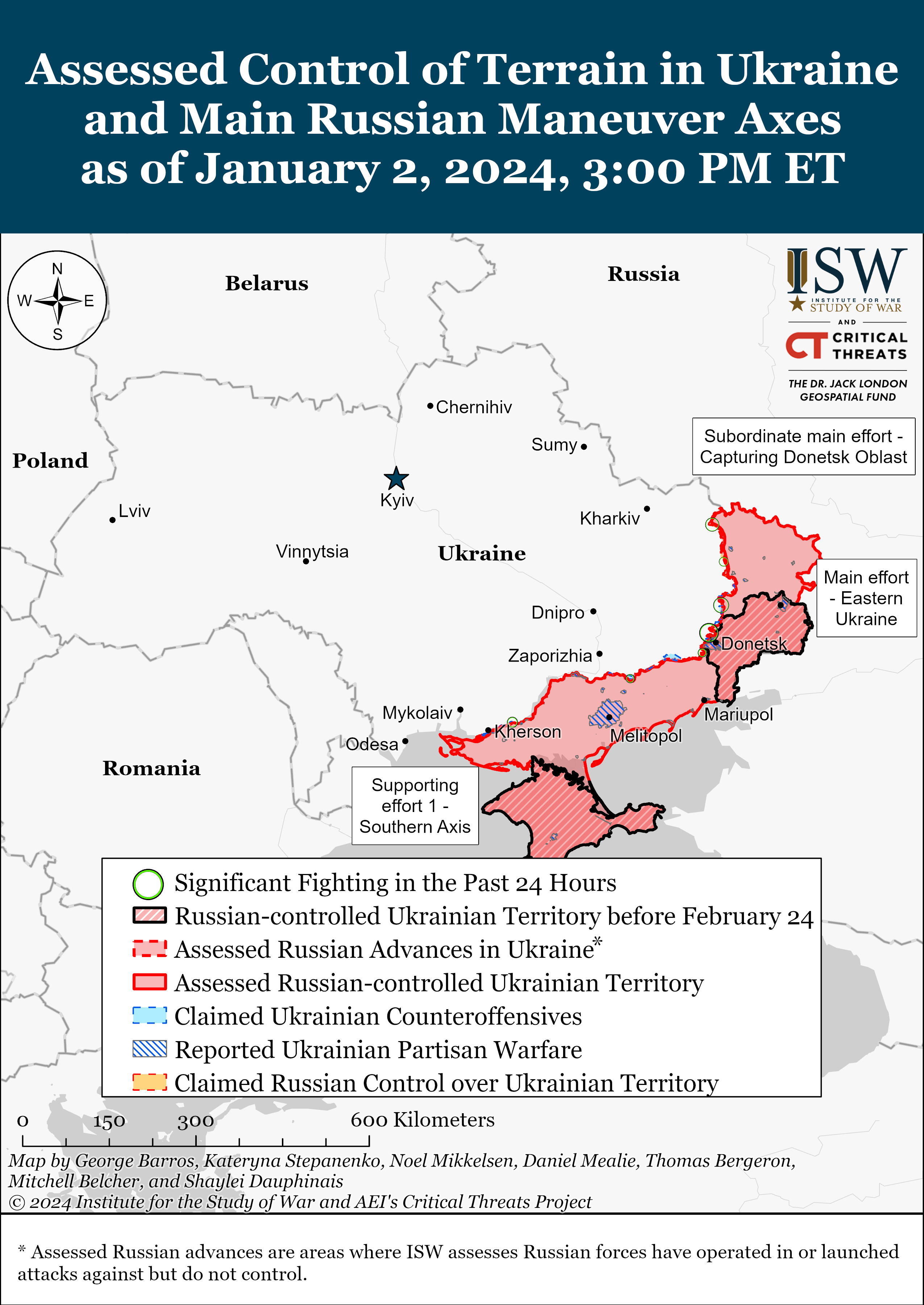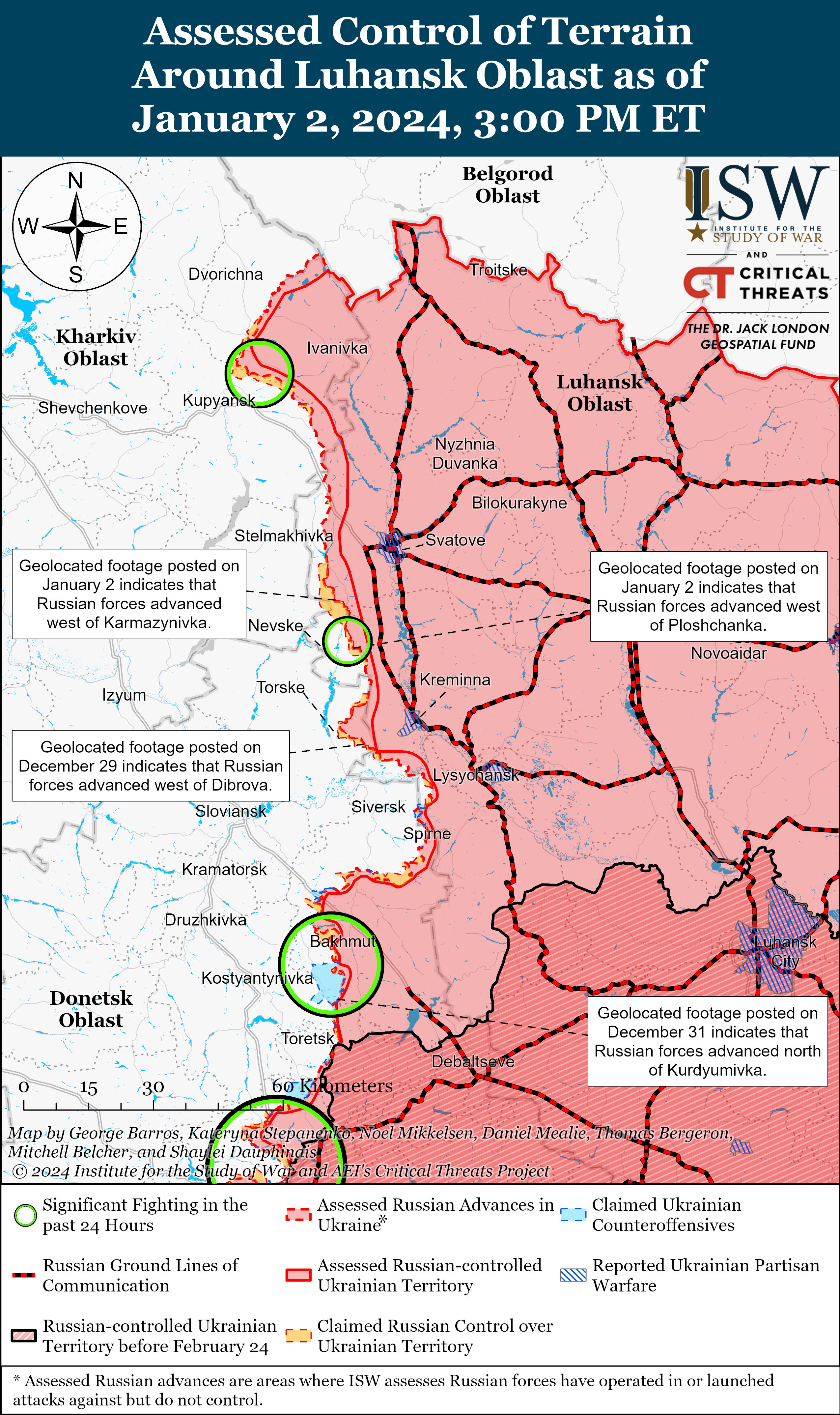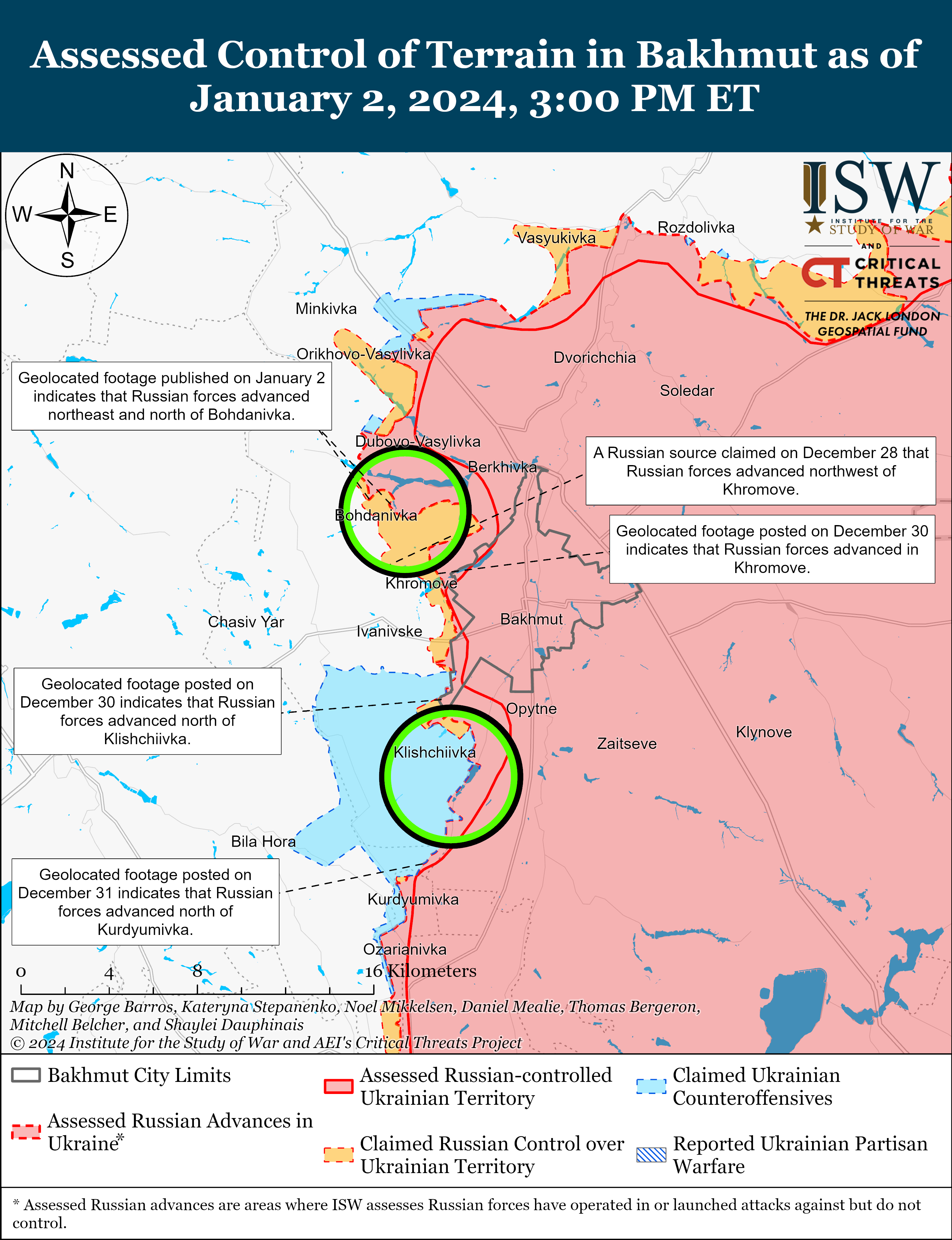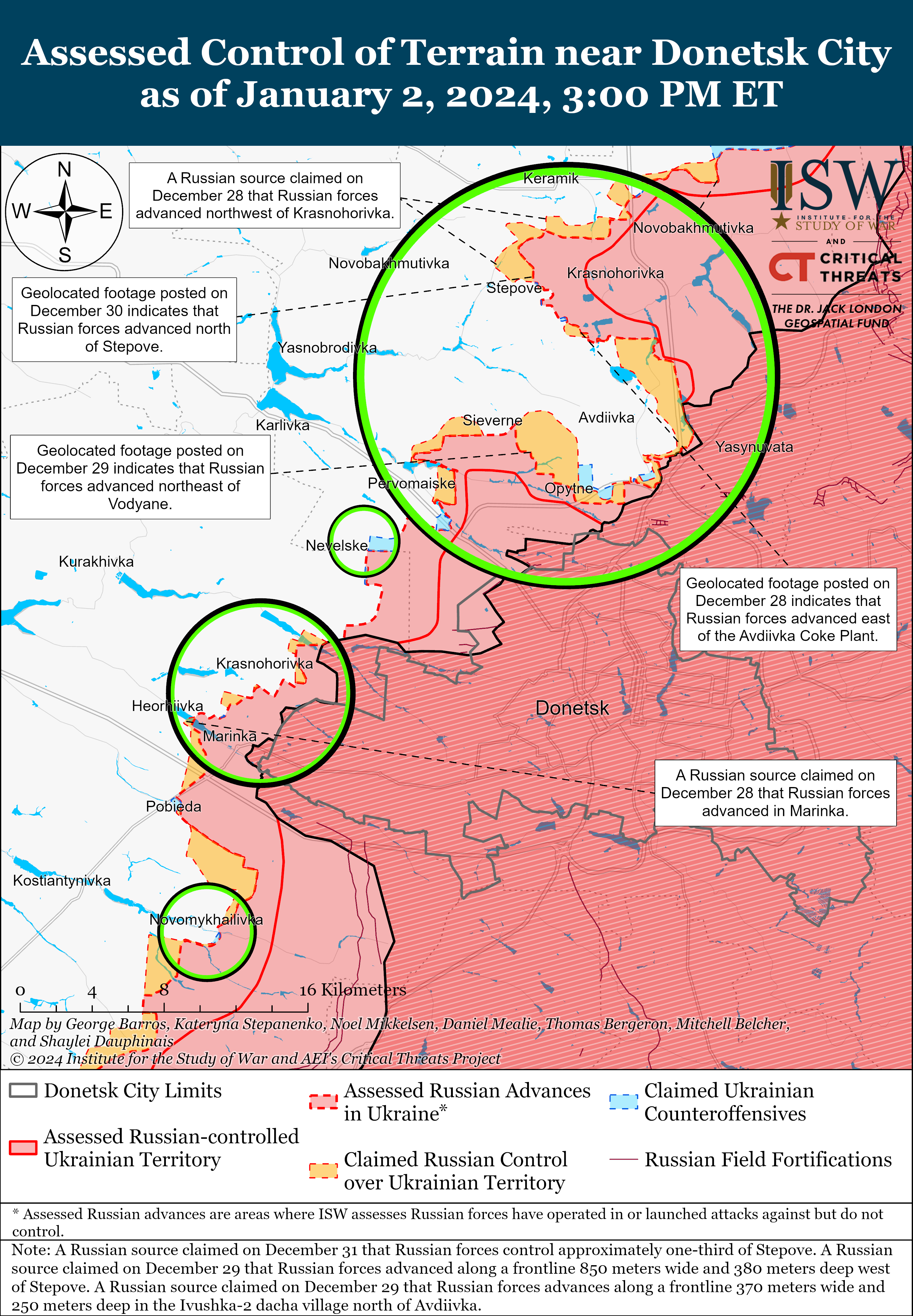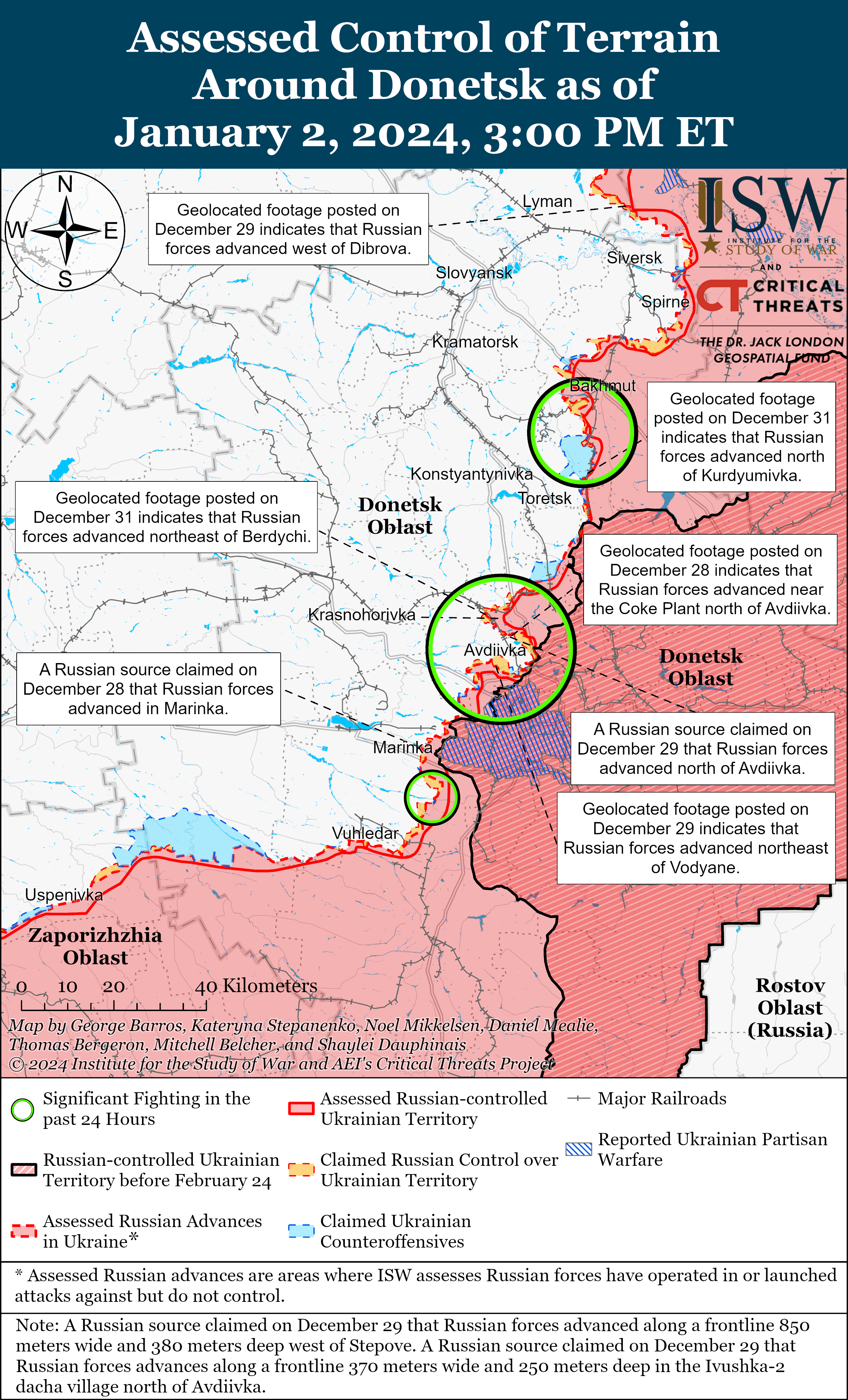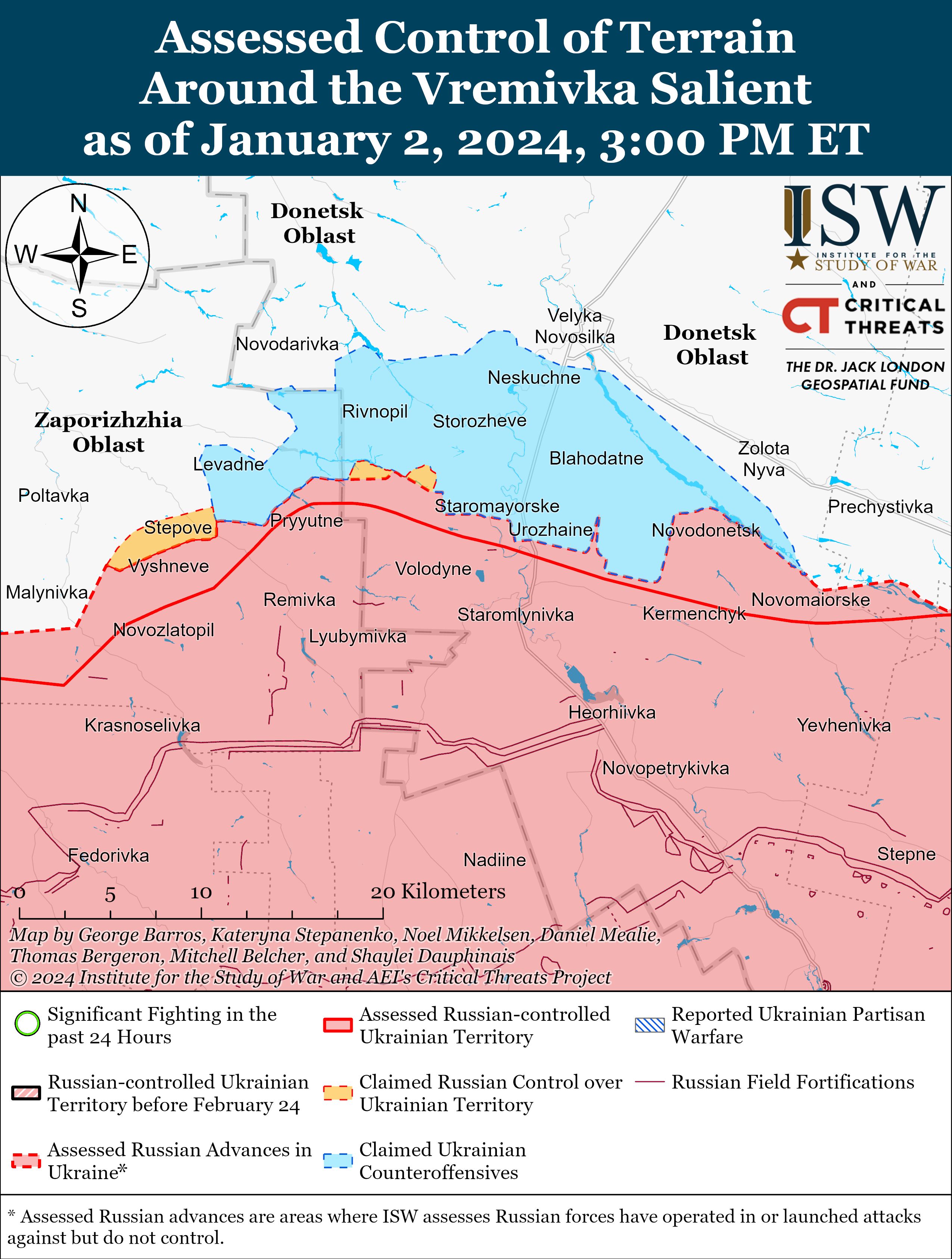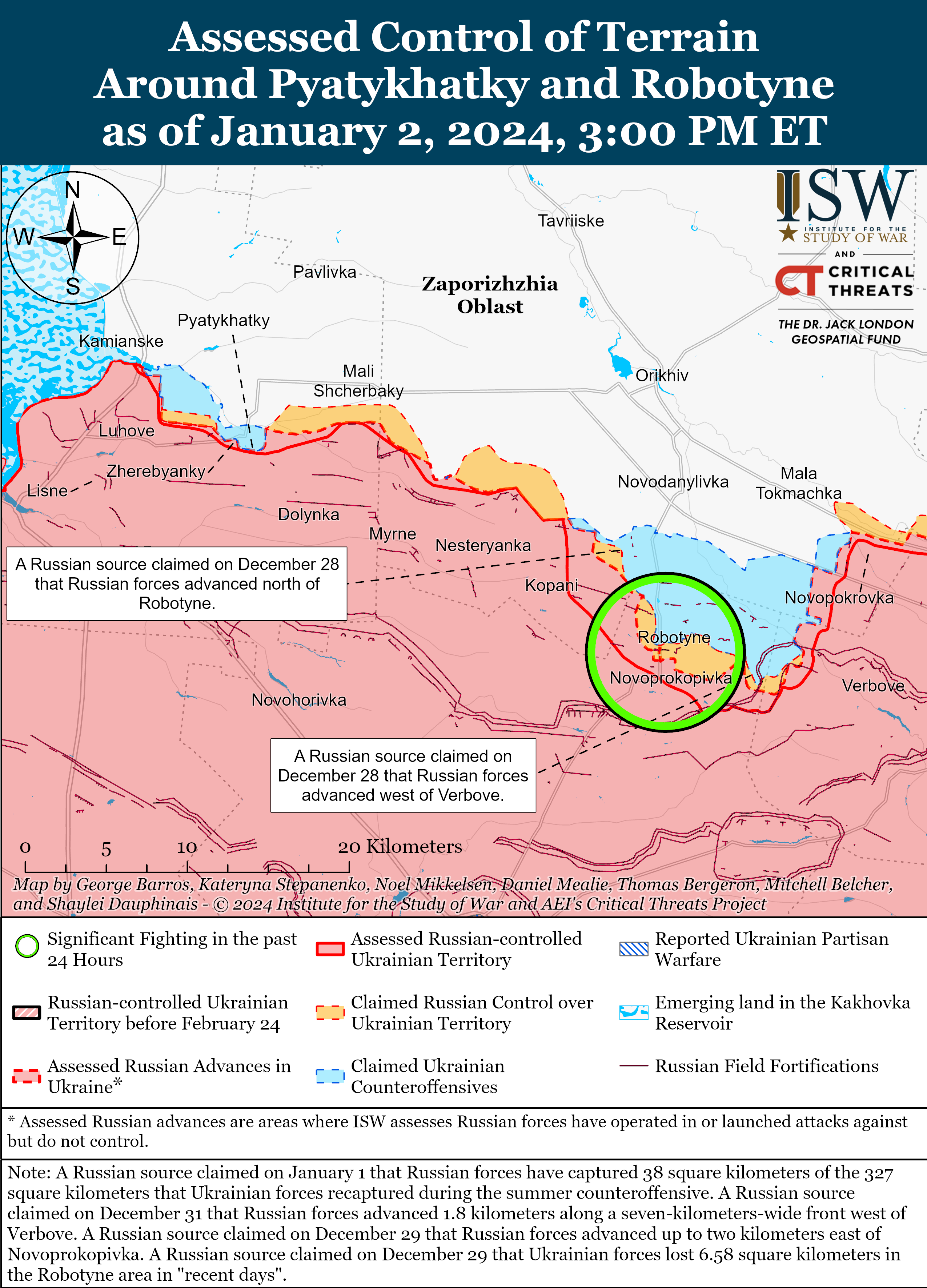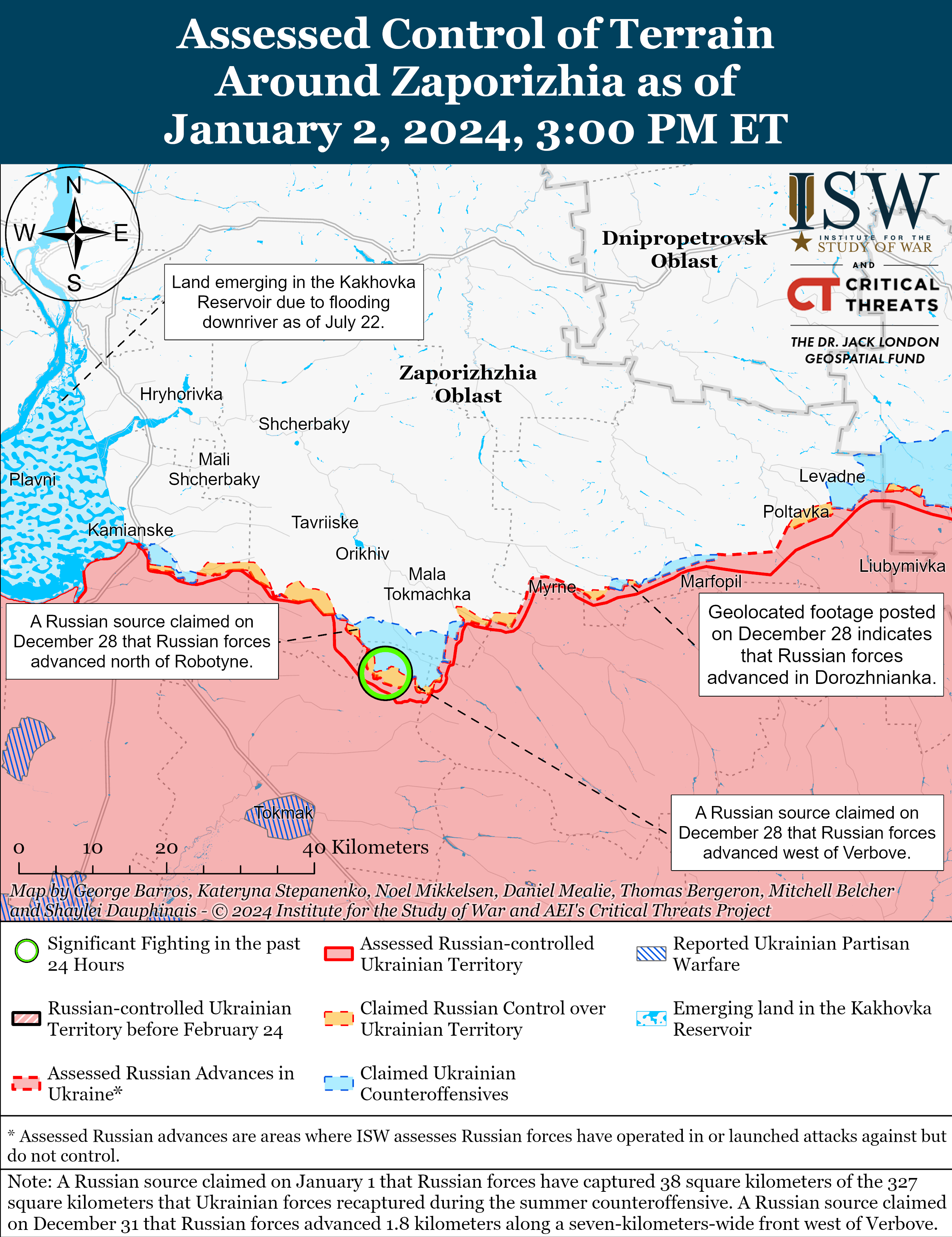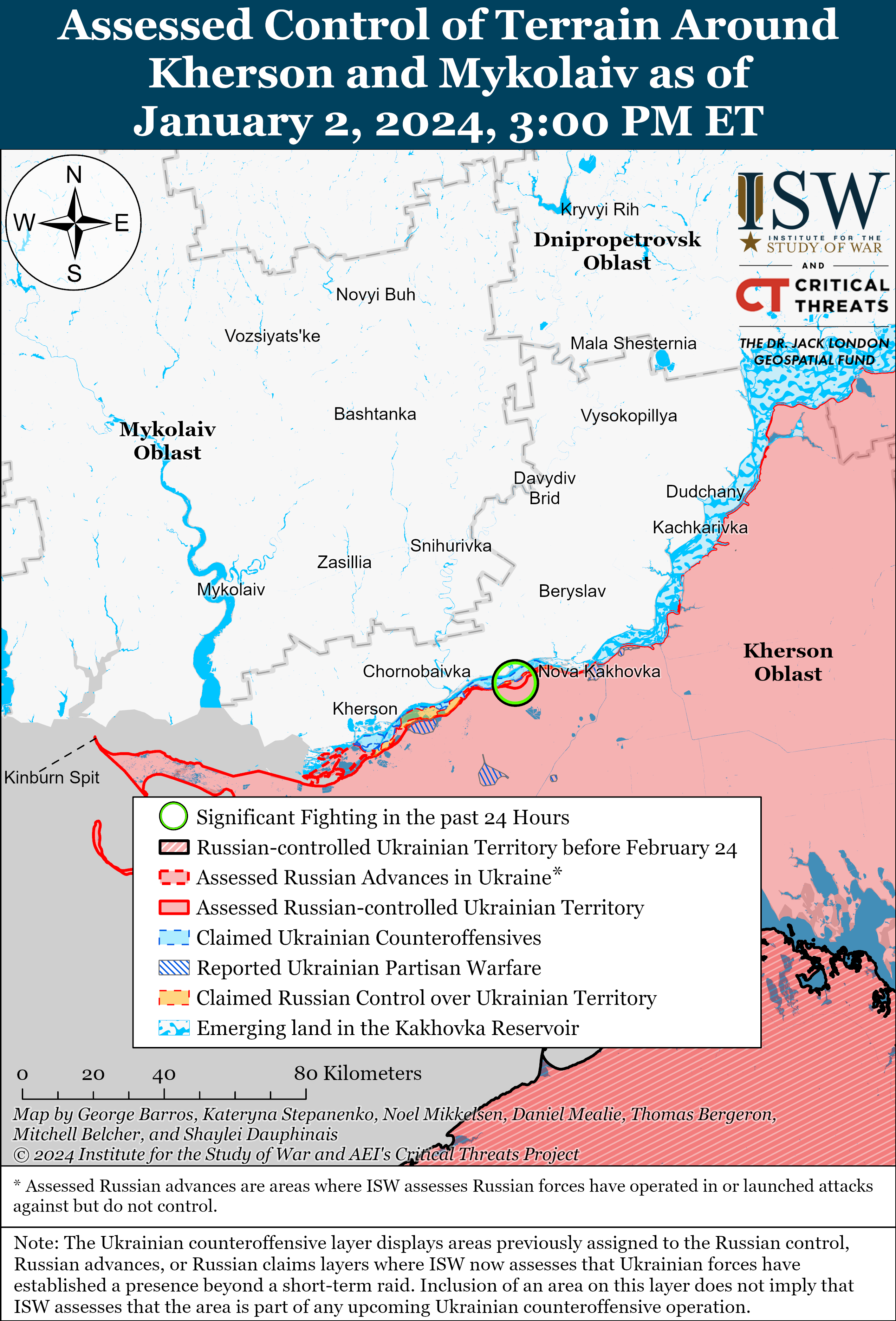Russian Offensive Campaign Assessment, January 2, 2024
Kateryna Stepanenko, Karolina Hird, Christina Harward, Grace Mappes, Angelica Evans, and Frederick W. Kagan
January 2, 2024, 8:20pm ET
Click here to see ISW’s interactive map of the Russian invasion of Ukraine. This map is updated daily alongside the static maps present in this report.
Click here to see ISW’s 3D control of terrain topographic map of Ukraine. Use of a computer (not a mobile device) is strongly recommended for using this data-heavy tool.
Click here to access ISW’s archive of interactive time-lapse maps of the Russian invasion of Ukraine. These maps complement the static control-of-terrain map that ISW produces daily by showing a dynamic frontline. ISW will update this time-lapse map archive monthly.
Note: The data cut-off for this product was 2:30 pm ET on January 2. ISW will cover subsequent reports in the January 3 Russian Offensive Campaign Assessment.
Russian President Vladimir Putin identified the West as Russia’s “enemy” and implied that Russia is fighting in Ukraine in order to defeat the West. Putin responded to a Russian serviceman’s question about Western aid to Ukraine during a meeting at a military hospital in Moscow Oblast on January 1, stating that Russia’s issue is not necessarily that the West is aiding Ukraine, but rather that the West is Russia’s “enemy.”[1] Putin added that “Ukraine by itself is not an enemy for [Russia],” but that Western-based actors “who want to destroy Russian statehood” and achieve the “strategic defeat of Russia on the battlefield” are Russia’s enemies. Putin claimed that Western elites are trying to break Russia into five parts and are trying to do so using Ukraine, but that the situation on the frontlines is changing and that Russia will “deal with the [West] faster” than the West can deal with Russia on the battlefields in Ukraine. Putin added that the problem is not in Western aid deliveries to Ukraine and noted that Ukraine has already been “completely destroyed,” that there is “nothing left” of the country, and that it “exists only on handouts.”
Putin implied that Russia is fighting an existential war against the West in Ukraine and noted that Western rhetoric has recently refocused on how to “quickly end the conflict.” This phrasing implies that Putin sees a conflict and potential negotiations between Russia and the West – not a conflict and potential negotiations between Russia and Ukraine. Putin added that Russia also wants to end the Russia-West conflict but only on the Kremlin’s terms and emphasized that Russia will not give up its positions. Putin does not view Ukraine as an independent actor and is thus portraying his full-scale invasion of Ukraine as a confrontation between Russian and West – deliberately misrepresenting the reality that Russia invaded Ukraine to destroy Ukraine’s sovereignty and territorial integrity. Putin’s emphasis on changing narratives in the West may indicate that he will perceive and/or frame any wavering in Western support for Ukraine and any Ukrainian defeats on the battlefield as a Russian victory in this supposed Russian-Western confrontation.
Putin’s framing of his war in Ukraine as a Russian struggle against the West – and not Ukraine – indicates that he does not intend to negotiate in good faith with Ukraine and is setting information conditions aimed at convincing the West to betray Ukraine through negotiations. Putin is likely deliberately and falsely framing Ukraine as pawn without agency in the Russia-West conflict to mask his expansionist and maximalist goals of establishing full effective Russian control of Ukraine. Putin’s January 1 discussion of negotiations refers to his intent to negotiate solely with the West about Ukraine’s future within the Russian sphere of influence and only about Western abandonment of Ukraine. It does not signal that Putin is interested in negotiating with Ukraine as an autonomous actor. Putin previously adopted a similar line when issuing two ultimatums to the United States and NATO in December 2021, which were intended to force the West to recognize Russia’s sphere of influence in Eastern Europe by surrendering essential elements of Ukraine’s sovereignty in the name of de-escalating the conflict between the West and Russia that Putin was inflaming.[2] Any Western commitment to negotiations about Ukraine’s future that bypass Ukraine will signal to Russia that it can impose its will upon countries that it deems to be in its sphere of influence – even countries beyond Ukraine, and potentially including Finland and Moldova, about which various Russian actors have begun setting informational conditions for future campaigns.[3]
Putin may be expanding his war aims in Ukraine to include confrontation with the West in an effort to set conditions for permanent Russian military buildup and to justify high battlefield sacrifices. Russia gained almost no meaningful ground in 2023 at a high manpower cost, despite Putin’s January 1 absurd claims that he only orders Russian servicemen to launch offensives that will not generate significant casualties.[4] The UK Ministry of Defense (MoD), however, stated on December 30 that “the average daily number of Russian casualties in Ukraine has risen by almost 300 during the course of 2023” and that Russian casualties could rise to over half a million by the end of 2024.[5] A declassified US intelligence assessment shared with Congress on December 12 stated that Russian forces have lost 315,000 personnel since the beginning of its full-scale invasion of Ukraine.[6] Such high casualties for small territorial gains are likely prompting Putin to present a strong and ideological justification to continue the prolonged war of choice on which he has launched Russia. Ukraine needs no such contorted justifications for the high losses and suffering that Putin’s invasion is inflicting on its people, even when Ukraine’s military operations do not produce the desired results. The war really is existential for Ukraine as it is not for Russia.
Putin notably concluded his observations about the Russian-West conflict by telling one wounded serviceman in the hospital that the serviceman did not get wounded for Russia to give up everything and surrender. Putin also addressed several domestic concerns about the lack of housing and compensations to servicemen who have received injuries on the battlefield, thereby attempting to posture himself as an empathetic and involved wartime leader even while seemingly raising the stakes to support his demands for increasing sacrifices by his people. Putin’s statements likely suggest that he is preparing a long-term justification to keep forces mobilized and engaged in combat for the perpetual defense of Russia’s sovereignty against the West.
Ukrainian President Volodymyr Zelensky stressed Ukraine’s need for urgent Western support to protect both Ukraine and the rest of Europe in an interview with the Economist published on January 1.[7] Zelensky warned that the West has lost its sense of urgency and that some Ukrainians have lost a sense of the existential threat that Russia poses to Ukraine. Zelensky emphasized that Europe needs to support Ukraine not solely to protect Ukraine but also to protect Europe, as Russian President Vladimir Putin will continue fighting further west if Ukraine loses. Zelensky added that the speed of Ukrainian military success depends on Western military assistance. Zelensky noted that the idea that Putin is “winning” the war is false and that there are no indications that Russia is willing to engage in meaningful peace negotiations, citing recent massive Russian drone and missile strikes against Ukrainian civilian infrastructure as evidence of Putin’s continued pursuit of his maximalist objectives. Zelensky assessed that Crimea and the Black Sea will be the center of gravity for military operations in 2024 and noted that a successful Ukrainian operation in Crimea, particularly an operation that would isolate Crimea and degrade Russian military operations there, would have a significant effect on Russia.
Russian forces conducted another massive series of drone and missile strikes against deep rear areas in Ukraine between December 31 and January 2, one of which used a strike package similar to that used on December 29, and to which Ukrainian forces appear to be adapting. Ukrainian military officials stated that overnight on December 31 to January 1 Russian forces launched 90 Shahed-136/131 drones from Cape Chauda and Balaklava (occupied Crimea); Kursk Oblast; and Primorsko-Akhtarsk, Krasnodar Krai and that Ukrainian forces shot down 87 of the drones.[8] Ukrainian officials stated that Russian forces also launched four S-300 missiles, three Kh-31P missiles, and one Kh-59 missile from occupied Kherson and Zaporizhia oblasts on January 1. The Ukrainian General Staff reported that later in the afternoon on January 1, Russian forces later launched an additional 10 Shahed drones and one Kh-59 missile, and that Ukrainian forces shot down nine of the drones and the missile.[9] Ukrainian officials stated that the Russian strikes damaged a museum and part of the Lviv National Agrarian University in Lviv City and residential buildings in Odesa City and Esma, Sumy Oblast.[10] The Russian Ministry of Defense (MoD) claimed that the Russian strikes on December 31 targeted unspecified Ukrainian airfields, although ISW has not yet been able to confirm strikes against Ukrainian airfield infrastructure.[11] Russian President Vladimir Putin claimed on January 1 that Russian strikes on January 2 would target military infrastructure in Ukraine like the strikes on January 1.[12]
Russian forces then conducted another massive series of missile and drone strikes overnight on January 1-2 and during the day on January 2. The Ukrainian Air Force reported that Russian forces launched 35 Shahed drones; 10 Kh-47 Kinzhal hypersonic missiles; 70 Kh-101/555/55 missiles; 12 Iskander-M, S-300, and S-400 ballistic missiles; four Kh-31P anti-radar missiles; and three Kalibr missiles at Ukraine on the night of January 1-2 and the morning of January 2 and that Ukrainian forces shot down 59 of the Kh-101/555/55 missiles and all of the drones, Kinzhal missiles, and Kalibr missiles.[13] Ukrainian Commander-in-Chief General Valerii Zaluzhnyi stated on January 2 that Ukrainian forces shot down a record number of 10 Kinzhal hypersonic missiles with Western-provided Patriot systems.[14] Ukrainian officials stated that the Russian strikes caused damage in Kyiv and Kharkiv cities.[15] The Russian MoD claimed that the Russian strikes targeted Ukrainian weapons storage sites and defense industrial base (DIB) enterprises, including those that produce missiles and drones and repair military equipment in Kyiv City and its suburbs, and Zaluzhnyi confirmed that there were hits to civilian, critical, and military infrastructure.[16]
Western provision of air defense systems and missiles to Ukraine remains crucial for Ukraine as Russian forces will likely attempt to adapt to Ukrainian air defense capabilities. Ukrainian military officials largely characterized the weapons composition of munitions used and the number of Russian strikes on January 1-2 as comparable to those on December 29, 2023.[17] Ukrainian forces notably shot down more Shahed drones and Kinzhal missiles on January 1-2 than on December 29, suggesting that Ukrainian forces may have adapted to the type of strike package Russian forces employed on December 29, likely after months of experimentation and testing Ukrainian air defenses using various weapons systems, strike routes, and air defense mitigation tactics.[18] Russian strikes on Ukraine are part of an ongoing tactical and technological offense-defense race wherein both sides are constantly experimenting and adapting to the other, particularly in the realm of long-range strikes and air defense. Western aid to Ukraine remains crucial as Russian forces will likely continue to experiment and innovate new ways to penetrate Ukrainian air defenses. ISW continues to assess that the end of Western aid to Ukraine would likely set conditions for an expanded Russian air campaign in Ukraine and eventually result in significant Russian advances further west, likely all the way to the western Ukrainian border with NATO member states.[19] UK outlet the Telegraph cited analysts on January 1 who stated that Ukraine may have to ration its air defense missiles in the face of decreasing Western aid in order to protect targets it deems to be the most important, which would likely expose critical frontline areas if Ukraine is forced to withdraw air defense systems to cover critical population centers.[20] Ukrainian Foreign Minister Dmytro Kuleba called on Western countries to expedite deliveries of air defense systems and ammunition to Ukraine and provide Ukraine with combat drones and long-range missiles.[21] Several Western officials condemned the Russian strikes on January 2 and noted Ukraine’s need for air defenses.[22]
Russian officials publicly defined the goals for Russia’s 2024 chairmanship of both BRICS and the Commonwealth of Independent States (CIS), articulating how the Kremlin may intend to use these organizations to fulfill its foreign policy objectives this year. Russian President Vladimir Putin stated during a speech on January 1 that Russia will promote political, economic, and cultural cooperation during its BRICS chairmanship and prioritize “strengthening multilateralism for equitable global development and security.”[23] Putin stated that the accession of Egypt, Iran, the United Arab Emirates, Saudi Arabia, and Ethiopia to BRICS demonstrates the organization’s “growing authority” in the world and that BRICS is attracting ”like-minded” countries that respect sovereign equality and desire a multipolar world order.[24]
The Russian government also published a list of priorities for its CIS chairmanship on January 1, which includes increased military cooperation, sanctions evasion, and joint “military-patriotic education and the popularization of common spiritual and moral values.”[25] The CIS’ rotating chairmanship is something of a formality due to Russia’s outsized influence on the CIS generally.[26] Russia’s emphasis on unspecified “common spiritual and moral values” in the CIS follows Putin’s emphasis in his annual New Year’s address on December 31, 2023, on ideological concepts such as Russian “multinationalism” and family values that fit into his wider ideology of the Russian World (Russkiy Mir).[27] ISW previously assessed that Putin is trying to re-establish the conception of the Russian World as the backbone of Russian domestic and foreign policy and is working to create an international order, through organizations such as BRICS and CIS, that will readily accept Russian principles, including the Kremlin’s claimed right to own Ukraine.[28]
The Norwegian government announced on January 1 that it is permitting Norwegian defense companies to sell weapons and defense-related products directly to the Ukrainian government. The new policy, which went into effect on January 1, allows Norwegian defense industrial base (DIB) companies to apply to the Ministry of Foreign Affairs (MFA) for export licenses to sell these products to Ukraine, and the Norwegian MFA will consider each application on a case-by-case basis.[29] Norwegian Foreign Minister Espen Barth Eide reiterated the need for ongoing support to Ukraine to defend against Russia’s war of aggression.[30]
The Turkish government announced on January 2 that it will not allow the United Kingdom (UK) to transport two mine hunting ships to Ukraine via the Turkish Straits “as long as the war continues.”[31] Turkey cited Article 19 of the Montreux Convention Regulating the Regime of the Turkish Straits, which stipulates that “vessels of war belonging to belligerent Powers shall not…pass through the Straits.”[32] Turkey has used the Montreux Convention to deny access to Russian warships wishing to pass through the Bosphorus and Dardanelles straits since February 28, 2022.[33] UK Defense Minister Grant Shapps announced on December 11 that the UK transferred two Sandown-class minehunter vessels to Ukraine as part of a plan that predated Russia’s full-scale invasion of Ukraine.[34]
Russian society continues to reckon with the impacts of increasing anti-migrant sentiment amid Russian authorities’ ongoing efforts to systematically disenfranchise migrant communities within Russia. Several Russian milbloggers and sources amplified footage posted on January 1 that shows a small group of apparently intoxicated adolescents, reportedly the children of Central Asian migrants, cursing at and later fighting with demobilized Russian veterans of the “special military operation” in Chelyabinsk.[35] The Russian Investigative Committee later detained three suspects—two 18-year-olds and a 17-year-old—and referred to them as “foreign citizens.”[36] Russian milbloggers seized on the incident and called for harsh and dehumanizing punishment for the adolescents while fixating on their Central Asian ethnicities and whether they and their parents are Russian citizens.[37] Russian outlet Fontanka additionally reported on January 1 that law enforcement in central St. Petersburg detained nearly 3,000 migrants during document checks on New Year’s Eve, 600 of whom were reportedly residing in Russia in some violation of migration law and 100 of whom now face deportation.[38] Russian opposition outlet Novaya Gazeta claimed that up to 1,500 of the detainees have already been coerced to sign contracts with the Russian MoD, which is consistent with a general increase in mobilization raids against migrant communities in Russia, as ISW has previously reported.[39] Russian information space actors, particularly the ultranationalist milblogger community, tend to fixate on singular incidents that implicate migrant communities in acts of violence or resistance in order to weaponize xenophobic and anti-migrant rhetoric, often to suggest that migrant communities should face wider rates of mobilization and fight in Ukraine.[40]
Key Takeaways:
- Russian President Vladimir Putin identified the West as Russia’s “enemy” and implied that Russia is fighting in Ukraine in order to defeat the West.
- Putin’s framing of his war in Ukraine as a Russian struggle against the West – and not Ukraine – indicates that he does not intend to negotiate in good faith with Ukraine and is setting information conditions aimed at convincing the West to betray Ukraine through negotiations.
- Putin may be expanding his war aims in Ukraine to include confrontation with the West in an effort to set conditions for permanent Russian military buildup and to justify high battlefield sacrifices.
- Ukrainian President Volodymyr Zelensky stressed Ukraine’s need for urgent Western support to protect both Ukraine and the rest of Europe in an interview with the Economist published on January 1.
- Russian forces conducted another massive series of drone and missile strikes against deep rear areas in Ukraine between December 31 and January 2, one of which used a strike package similar to that used on December 29, and to which Ukrainian forces appear to be adapting.
- Western provision of air defense systems and missiles to Ukraine remains crucial for Ukraine as Russian forces will likely attempt to adapt to Ukrainian air defense capabilities.
- Russian officials publicly defined the goals for Russia’s 2024 chairmanship of both BRICS and the Commonwealth of Independent States (CIS), articulating how the Kremlin may intend to use these organizations to fulfill its foreign policy objectives this year.
- The Norwegian government announced on January 1 that it is permitting Norwegian defense companies to sell weapons and defense-related products directly to the Ukrainian government.
- The Turkish government announced on January 2 that it will not allow the United Kingdom (UK) to transport two mine hunting ships to Ukraine via the Turkish Straits “as long as the war continues.”
- Russian society continues to reckon with the impacts of increasing anti-migrant sentiment amid Russian authorities’ ongoing efforts to systematically disenfranchise migrant communities within Russia.
- Russian forces made marginal confirmed advances along the Svatove-Kreminna line, northwest and southwest of Bakhmut, northwest of Avdiivka, and southwest of Donetsk City.
- The Russian military command may be seeking avenues to re-pardon recidivists who previously fought in the war in Ukraine in an apparent effort to maintain Russia’s ability to leverage convict recruits as a manpower resource.
- Russian occupation authorities are restricting and likely monitoring internet communications ahead of the March 2024 presidential elections.
We do not report in detail on Russian war crimes because these activities are well-covered in Western media and do not directly affect the military operations we are assessing and forecasting. We will continue to evaluate and report on the effects of these criminal activities on the Ukrainian military and the Ukrainian population and specifically on combat in Ukrainian urban areas. We utterly condemn Russian violations of the laws of armed conflict and the Geneva Conventions and crimes against humanity even though we do not describe them in these reports.
- Russian Main Effort – Eastern Ukraine (comprised of two subordinate main efforts)
- Russian Subordinate Main Effort #1 – Capture the remainder of Luhansk Oblast and push westward into eastern Kharkiv Oblast and encircle northern Donetsk Oblast
- Russian Subordinate Main Effort #2 – Capture the entirety of Donetsk Oblast
- Russian Supporting Effort – Southern Axis
- Russian Mobilization and Force Generation Efforts
- Russian Technological Adaptations
- Activities in Russian-occupied areas
- Russian Information Operations and Narratives
Russian Main Effort – Eastern Ukraine
Russian Subordinate Main Effort #1 – Luhansk Oblast (Russian objective: Capture the remainder of Luhansk Oblast and push westward into eastern Kharkiv Oblast and northern Donetsk Oblast)
Russian forces recently made marginal territorial gains southwest of Svatove and northwest Kreminna. Geolocated footage published on January 2 showed that Russian forces advanced west of Karmazynivka (11km southwest of Svatove) and Ploshchanka (15km northwest of Kreminna).[41] A Russian milblogger claimed on January 2 that Russian forces marginally advanced near Synkivka and captured one unspecified position on the east bank of the Oskil River, but ISW has not observed visual evidence for this claim.[42] Russian and Ukrainian forces also continued positional engagements on January 1 and January 2 northeast of Kupyansk near Synkivka and east of Petropavlivka; southwest of Svatove near Makiivka; west of Kreminna near Terny and Torske; and south of Kreminna in the Serebryanske forest area.[43] A likely Ukrainian Telegram channel claimed that Ukrainian forces struck a concentration area of the “Kuban” BARS-16 (Russian Combat Army Reserve) Cossack volunteer detachment based in occupied Lysychansk, Luhansk Oblast.[44] Elements of the Luhansk People’s Republic’s (LNR) 7th Separate Guards Motorized Rifle Brigade (2nd LNR Army Corps) are operating south of Kreminna near Bilohorivka.[45]
Russian Subordinate Main Effort #2 – Donetsk Oblast (Russian objective: Capture the entirety of Donetsk Oblast, the claimed territory of Russia’s proxies in Donbas)
Russian forces recently made confirmed advances northwest and southwest of Bakhmut. Geolocated footage published on January 1 and 2 indicates that Russian forces advanced on the northern and eastern outskirts of Bohdanivka (northwest of Bakhmut).[46] Additional geolocated footage published on December 31 indicates that Russian forces advanced north of Kurdyumivka (southwest of Bakhmut).[47] Ukrainian and Russian sources stated that positional engagements continued northwest of Bakhmut near Bohdanivka and Khromove and southwest of Bakhmut near Klishchiivka, Andriivka, and Kurdyumivka.[48] Elements of the Russian 98th Airborne (VDV) Division reportedly advanced in western Khromove west of Bakhmut, although ISW has not observed visual confirmation of this claim.[49]
Russian forces recently made a confirmed advance northwest of Avdiivka as positional engagements continued near Avdiivka on January 1 and 2. Geolocated footage published on December 31 indicates that Russian forces advanced northwest of Stepove (north of Avdiivka).[50] A Russian milblogger claimed on January 1 and 2 that Russian forces advanced northwest of Avdiivka towards Berdychi and Ochertyne, and Ukrainian military observer Kostyantyn Mashovets stated on January 2 that Russian forces retreated after initially advancing towards Berdychi.[51] Russian and Ukrainian sources stated that positional fighting continued northwest of Avdiivka near Novobakhmutivka, Berdychi, the Avdiivka Coke Plant; and near Stepove; southeast of Avdiivka near the industrial zone; and southwest of Avdiivka near Pervomaiske and Nevelske.[52] Mashovets stated on January 2 that Stepove is a contested gray zone.[53] Mashovets also noted that elements of the 15th and 21st Motorized Rifle Brigades (both of the 2nd Combined Arms Army [CAA], Central Military District [CMD]) and 114th Motorized Rifle Brigade (1st Donetsk People’s Republic [DNR] Army Corps are operating north and northwest of Avdiivka, while elements of the 239th Tank Regiment (90th Tank Division, 41st CAA, CMD) are concentrating northeast of Avdiivka.
Russian forces made a confirmed advance southwest of Donetsk City, although this advance did not occur recently. Geolocated footage published on December 14 and geolocated on January 1 indicates that Russian forces previously marginally advanced in the northeastern outskirts of Novomykhailivka (southwest of Donetsk City).[54] Russian and Ukrainian sources stated that positional engagements continued near Marinka, Novomykhailivka, and Pobieda (southwest of Donetsk City) and towards Paraskoviivka (southwest of Donetsk City).[55] Elements of the “Russian Hawks” detachment of the DNR’s 33rd Motorized Rifle Regiment are reportedly operating near Novomykhailivka.[56]
Russian sources accused Ukrainian forces of conducting a strike against the Donbas Palace hotel in occupied Donetsk City on January 1, and unspecified Russian journalists are reportedly among the casualties. Russian state media and officials claimed that Ukrainian forces shelled Donetsk City just after midnight on January 1, and Donetsk People’s Republic (DNR) Head Denis Pushilin claimed that strikes against central Donetsk City killed four and injured 13.[57] Some Russian milbloggers claimed that the Donbas Palace strike killed at least one unspecified Russian military journalist or milblogger, and one notable milblogger complained that Russian media has not reported on this specific death.[58] Zaporizhia Oblast occupation official Vladimir Rogov claimed that the strike wounded ”several” Russian journalists.[59] Russian authorities have not offered information on the casualties except to claim that the casualties are civilians.[60] Ukrainian journalist Andriy Tsaplienko reported that unspecified members of the occupation elite had met at the Donbas Palace hotel with “guests from Moscow.”[61] ISW is unable to confirm Tsaplienko’s reporting, but reports of a high-profile dinner are consistent with milblogger claims of one or more Russian journalists being among the casualties of the hotel strike.
Russian Supporting Effort – Southern Axis (Russian objective: Maintain frontline positions and secure rear areas against Ukrainian strikes)
Russian and Ukrainian forces continued positional fighting in the Donetsk-Zaporizhia Oblast border area on January 1 and 2, but there were no confirmed changes to the frontline in this area. Russian and Ukrainian sources reported positional engagements south and southwest of Velyka Novosilka near Urozhaine, west of Staromayorske, north of Pryyutne, and south of Novodarivka.[62] Elements of the Russian 143rd Motorized Rifle Regiment (127th Motorized Rifle Division, 5th Combined Arms Army [CAA], Eastern Military District [EMD]) are reportedly operating north of Pryyutne.[63]
Ukrainian and Russian forces reportedly advanced in western Zaporizhia Oblast as positional engagements continued on January 1 and 2, but there were no confirmed changes to the frontline in this area. A Russian milblogger claimed on December 31 that Russian forces advanced in an unspecified area seven kilometers wide and 1.8 kilometers deep between Novoprokopivka (just south of Robotyne) and Verbove (east of Robotyne).[64] A prominent Russian milblogger claimed on January 1 that Ukrainian forces recaptured unspecified positions south of Verbove.[65] Ukrainian and Russian sources stated on January 1 and 2 that positional engagements continued west and south of Robotyne and near Verbove and Novofedorivka (northeast of Robotyne).[66] A Russian source claimed that Russian forces have recaptured 38 of the 327 square kilometers that Ukrainian forces captured during the summer 2023 counteroffensive on the Zaporizhia front, although ISW has not observed visual evidence of this claim.[67] A Russian milblogger claimed that weather conditions remain difficult in western Zaporizhia Oblast.[68] Ukrainian military observer Kostyantyn Mashovets stated that elements of the Russian 234th Airborne Assault (VDV) Regiment (76th VDV Division) and the 136th Separate Guards Motorized Rifle Brigade (58th CAA, Southern Military District [SMD]) advanced west of Robotyne from Kopani and that elements of the Russian 71st and 70th Motorized Rifle Regiments (both of the 42nd Motorized Rifle Division, 58th CAA, SMD) are operating in the northern part of Novoprokopivka.[69]
Positional fighting continued on the east (left) bank of Kherson Oblast on January 1 and 2, but there were no confirmed changes to the frontline in this area. Ukrainian forces repelled a slightly increased number of Russian ground attacks near Krynky (southwest of Kherson City) on January 1.[70] Russian forces reportedly conducted a strike with FAB-1500 glide bombs on Ukrainian positions in Kachkarivka (northwest of Kherson City) on the west (right) bank of Kherson Oblast.[71]
Russian Mobilization and Force Generation Efforts (Russian objective: Expand combat power without conducting general mobilization)
The Russian military command may be seeking avenues to re-pardon recidivists who previously fought in Ukraine in an apparent effort to maintain Russia’s ability to leverage convict recruits as a manpower resource. A Russian insider source claimed on January 2 that the number of domestic crimes committed by veterans of the war in Ukraine is increasing, which is prompting the Russian General Staff and Ministry of Defense (MoD) to consider pushing through legislation that would allow Russia authorities to “re-pardon” repeat offenders.[72] The de jure interpretation of the current law suggests that pardons cannot be granted to those who were previously pardoned or granted amnesty.[73] ISW previously reported in early 2023 that Russian President Vladimir Putin issued secret preemptive pardons to Russian convicts fighting for the Wagner Group before their release from penal colonies to fight in Ukraine, and the insider source suggested that these preemptively pardoned former Wagner fighters are now re-offending and returning to prison, where Russian military authorities seek to once again recruit them.[74] While ISW cannot independently confirm the insider source’s speculation, it is generally consistent with the Russian MoD’s consistent efforts to maintain recruitment efforts among the convict population.[75] The rate of recidivism would have to be high for there to be enough criminals in this category to attract the MoD’s attention.
The Donetsk People’s Republic (DNR) “Pyatnashka” volunteer brigade continues to amplify statements from international recruits in an effort to highlight its supposedly multinational appeal. “Pyatnashka” has recently posted videos featuring fighters reportedly from Japan, China, and Colombia.[76] BBC Russia Service previously reported on November 20, 2023, that the “Pyatnashka” battalion initially formed in 2014 on the basis of volunteers from the Russian-occupied Georgian region of Abkhazia and has participated in combat operations in Donetsk Oblast since its formation.[77] BBC Russia Service previously speculated that “Pyatnashka” may be subordinated to the Russian Ministry of Defense (MoD)-affiliated “Redut” private military company.
The Russian law raising the upper limit of the conscription age from 27 to 30 years of age officially came into force on January 1.[78] Putin previously signed the law on raising the upper bound of the conscription age on August 4, 2023.[79] The law maintains the lower limit of the conscription age at 18 years of age and stipulates that eligible men who turned 27 in 2023 will enter the reserves instead of the active service.[80] This law will therefore impact the incoming spring 2024 conscript cycle, which will run between April 1 to July 15, 2024.[81]
Russian Technological Adaptations (Russian objective: Introduce technological innovations to optimize systems for use in Ukraine)
Russia continues efforts to mitigate international sanctions and secure electronic components for the Russian defense industrial base (DIB). The Ukrainian Resistance Center reported on January 2 that Russia is planning to finance the creation of shell companies based in Uzbekistan for the purchase of electronic components that will be used in Russian drones.[82] The Ukrainian Resistance Center claimed that Russian President Vladimir Putin secretly discussed these efforts during a meeting with Uzbek President Shavkat Mirziyoyev at the Commonwealth of Independent States (CIS) meeting on December 26.[83]
The Russian ZALA Aero Group highlighted the role of its Lancet reconnaissance and strike drones on the battlefield in Ukraine.[84] ZALA claimed that it has confirmed the use of 872 Lancet drones in Ukraine as of December 29, 2023, and claimed that Lancet drones had an 80 percent success rate in destroying targets during this timeframe.
Activities in Russian-occupied areas (Russian objective: Consolidate administrative control of annexed areas; forcibly integrate Ukrainian citizens into Russian sociocultural, economic, military, and governance systems)
Russian occupation authorities are restricting and likely monitoring internet communications in occupied areas of Ukraine ahead of the March 2024 presidential elections. The Ukrainian Resistance Center reported that Russian occupation authorities are planning to restrict internet access in occupied Ukraine to those with Russian citizenship, and Russian authorities will likely monitor this limited usage to compel compliance with Russian authorities ahead of the presidential elections.[85] Ukrainian Luhansk Oblast Military Administration Head Artem Lysohor reported on January 2 that Luhansk People’s Republic (LNR) authorities turned on mobile internet for the presidential election campaign, having turned it off for most of the past year.[86]
Russian authorities continue to deport Ukrainian children amid Ukrainian efforts to recover previously deported Ukrainian children. The Ukrainian Ministry of Reintegration of the Temporarily Occupied Territories reported that five of 31 Ukrainian children whom Russia deported from occupied Mariupol have returned to Ukraine.[87] The Kherson Oblast occupation Ministry of Culture claimed that it deported 1,100 Ukrainian children to Moscow and St. Petersburg through educational and cultural schemes in 2023.[88]
Russian Information Operations and Narratives
Chairperson of the State Duma Commission on Investigations of Foreign Interference in Internal Affairs Vasily Piskarev ridiculed the US Embassy’s New Year’s greetings to Russian citizens on January 1. Piskarev claimed that the embassy encouraged Russians to participate in illegal protests against the Russian full-scale invasion of Ukraine.[89] Piskarev said that the embassy’s claimed commitment to have a dialogue with Russians who want a constructive future is “a clear provocation and interference in the internal affairs of [Russia].”
Significant activity in Belarus (Russian efforts to increase its military presence in Belarus and further integrate Belarus into Russian-favorable frameworks and Wagner Group activity in Belarus)
Nothing significant to report.
Note: ISW does not receive any classified material from any source, uses only publicly available information, and draws extensively on Russian, Ukrainian, and Western reporting and social media as well as commercially available satellite imagery and other geospatial data as the basis for these reports. References to all sources used are provided in the endnotes of each update.

[14] https://armyinform dot com.ua/2024/01/02/valerij-zaluzhnyj-nazvav-rekordom-zbyttya-sylamy-ppo-10-raket-kyndzhal/
[29] https://www.regjeringen dot no/en/aktuelt/direct-sales-of-weapons-and-defense-related-products-to-ukraine-permitted-from-1-january-2024/id3020487/
[30] https://www.regjeringen dot no/en/aktuelt/direct-sales-of-weapons-and-defense-related-products-to-ukraine-permitted-from-1-january-2024/id3020487/
[85] https://sprotyv.mod dot gov.ua/okupanty-planuyut-nadavaty-dostup-do-internetu-meshkantsyam-tot-lyshe-za-pasportom/
[87] https://minre dot gov dot ua/2024/01/02/povernuto-shhe-odnogo-deportovanogo-yunaka/


